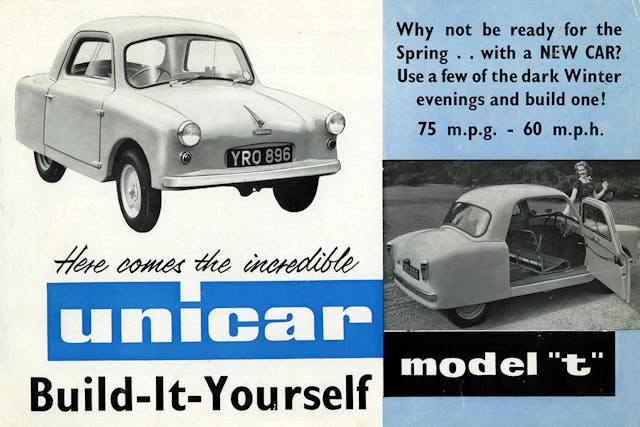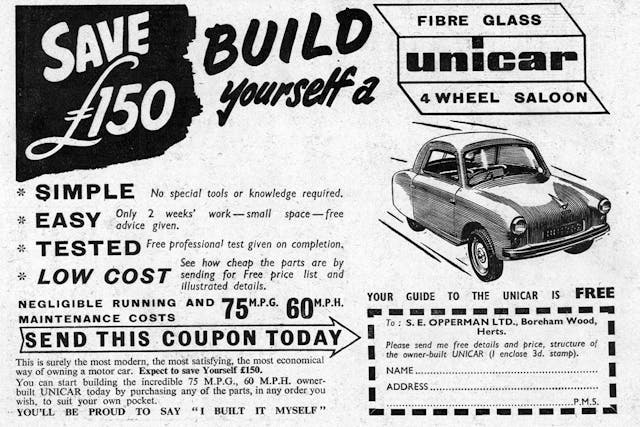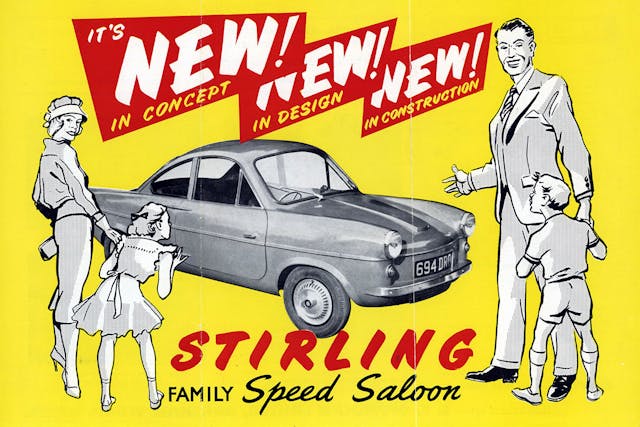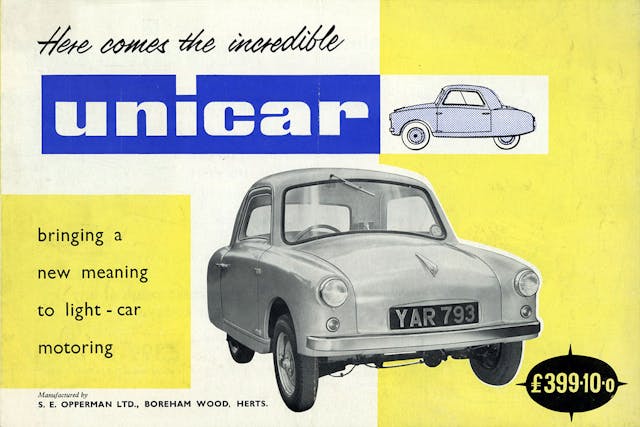Opperman Unicar: The Tiny, Cheap Family Car Killed by BMC’s Mini
When the London Motor Show opened its doors in 1956, there was a new economy car in town: Britain’s cheapest new car in fact, the Opperman Unicar, which was introduced to ride the microcar boom of the 1950s.
During the ’50s, consumerism grew sharply. Employment was high, people had money to spend, and credit was easier to come by than ever before. The result was a raft of cottage-industry car makers that sprang up with all sorts of cars that put economy above all else. This was the age of plastic body shells, which cut production costs enormously compared with the steel or aluminum alternatives.
Most of these cars featured tiny one- or two-cylinder engines of the type that nowadays might be deemed too tame for a lawnmower, but the world was a very different place in the 1950s, and pretty much anything went when it came to basic family transport. Not that many of these short-lived cars ever sold in big numbers.


The company behind the pint-sized Unicar was a tractor manufacturer based in Hertfordshire that decided that it should move into cheap family transport, and the result of its decision was a two-door saloon with enclosed rear wheels.
The Unicar’s body shell was made up of six plastic moldings which were bolted and bonded together to form a monocoque. In the rear was an Anzani 322-cc two-cylinder two-stroke engine, which sent its 15 hp to the rear wheels via a three-speed manual gearbox. Despite such a puny powertrain the Unicar was reckoned to be capable of as much as 60 mph, largely because of the low weight of just over 660 pounds. Later models got even more power (18 hp) courtesy of a 328-cc Excelsior engine. (The idea of nudging motorway speeds in a Unicar must have been truly terrifying.)
Whereas the front track was a reasonably generous four feet, at the back it was 12 inches narrower, while the drum brakes front and rear were operated via cables rather than hydraulics. Even at urban speeds every journey in a Unicar must have been a white-knuckle ride.
Incredibly, despite its diminutive proportions (just 9.5 feet long and 4.6 feet wide) the Opperman Unicar was claimed to be a four-seater, with those in the front getting a hammock-style bench seat. The engine intruded into the cabin at the rear and on either side of this a small, flat box was molded into the floorpan; small kids were supposed to get comfy somehow.

Despite the fact that fierce competition in the economy car sector meant that sales were hard to come by, Opperman decided to expand the model range with the unveiling of the Stirling prototype in 1958. An attempt to take Opperman upmarket, the Stirling looked great and it had significantly more power thanks to the fitment of a 25 hp, 424-cc engine.
A second prototype followed in 1959, with a 500-cc engine for even easier cruising, but just as the Stirling was set to be introduced, the Mini Cooper burst onto the scene. As with so many microcar manufacturers, Opperman’s entire business became untenable overnight once the Mini was on sale; you could buy the BMC wonder for just £497 (roughly $12,200 today) whereas the Stirling weighed in at £541 (about $13,300). Game over.
***
Check out the Hagerty Media homepage so you don’t miss a single story, or better yet, bookmark it. To get our best stories delivered right to your inbox, subscribe to our newsletters.



I owned a ’60 Goggomobil coupe in the 2000s. It was one of the Unicar’s competitors, but way more successful, selling about 67,000 units from 1955-65. Air-cooled 250 cc 2-stroke twin in the rear made 13.6 HP, though my car had the “big engine” with 400 cc and 20 HP. It was considered a family car in Germany then, though the rear bench seat was mostly lacking foot room and padding. I’ve seen old movies of the sedan version pulling camping trailers in Europe. My Goggo was a blast to drive, though I wisely stayed off the more heavily travelled roads. The “blue highways” were its proper place. It made the round trip between Brookline MA and the top of Mt. Wachusett a couple of times in Gould’s Microcar Weekends. Never a breakdown.
The fact that the Unicar was offered as a kit, was likely due to the fact that kit cars had significant tax advantages in the UK then. The Lotus Elan was also sold in kit form, arguably the best engineered kit car ever.
I’m not surprised the Mini beat this car. It was far more practical and fun.
wow, sort of looks like my Nash Metro
Does anyone on this side of the Atlantic remember the Bond MiniCar? I had two, both little 3-wheelers, fiberglass and aluminum construction. I cylinder 197cc Villiars 2-stroke you started via kick starter after opening the bonnet! I drove one across metropolitan Portland, Oregon during rush hour one afternoon, surrounded by soccer mom’s in huge SUVs plus the giant lifted 4×4’s. Once was enough . . .